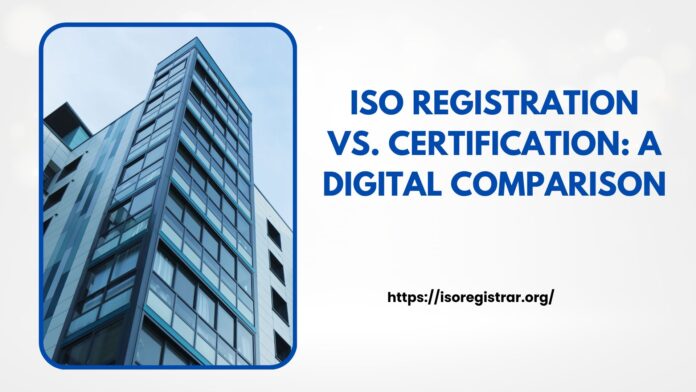Introduction
In the fast-paced and ever-evolving business landscape of today, organizations across the globe strive to enhance their credibility and competitiveness. One of the key methods they employ to achieve this is through ISO (International Organization for Standardization) compliance. ISO standards provide a framework for businesses to improve their operations, quality, and customer satisfaction. However, in the digital age, the terms “ISO registration” and “ISO certification” have often been used interchangeably, causing confusion. In this article, we delve into the crucial differences between ISO registration and certification, while exploring the impact of digital technology on these processes.
Understanding ISO Registration
ISO registration, also known as ISO registration audit or ISO registration assessment, refers to the initial step a company takes to signal its commitment to implementing ISO standards. During this process, a company invites a certifying body or registrar to assess its management system against the requirements of a specific ISO standard. However, ISO registration does not result in certification; rather, it signifies that the company is on the path to compliance.
ISO registration can be seen as a preliminary audit, wherein the company undergoes a thorough review of its policies, procedures, and processes to identify gaps in relation to the chosen ISO standard. This process helps the organization prepare for the more intensive ISO certification.
The Digital Impact on ISO Registration
The digital age has transformed the ISO registration process in several ways:
Online Documentation:
Companies can now upload their documentation, policies, and procedures to secure online platforms. This streamlines the registration process, making it more efficient and accessible.
Remote Auditing:
Digital tools and platforms have facilitated remote auditing, allowing certifying bodies to assess companies’ compliance without physically visiting their premises. This has reduced costs and time constraints associated with traditional on-site audits.
Data Analytics:
Digital platforms have enabled the collection and analysis of data related to ISO registration, offering valuable insights for process improvement and decision-making.
Understanding ISO Certification
ISO certification is the culmination of the ISO compliance journey. After successfully completing the ISO registration process, an organization can move forward with ISO certification. This entails a comprehensive assessment by a certifying body to determine if the company’s management system fully conforms to the ISO standard in question. Once certified, the company can display the ISO certification mark, demonstrating to stakeholders its commitment to quality and compliance.
ISO certification is typically valid for a specific period, after which the company must undergo regular surveillance audits to maintain certification. These audits ensure that the organization continues to meet the ISO standard’s requirements.
The Digital Impact on ISO Certification
Digitalization has had a profound impact on ISO certification as well:
Real-time Monitoring:
Digital tools allow for real-time monitoring of a company’s compliance status. This facilitates quicker decision-making and adaptability to changing circumstances.
Enhanced Transparency:
Digital platforms enable stakeholders to access certification status and related information, promoting transparency and trust.
Integration with Quality Management Systems (QMS):
Many organizations now integrate their ISO compliance efforts with QMS software, simplifying the certification process and improving overall quality management.
See Also: ISO 22000:2005 Certificate
Conclusion
In conclusion, ISO registration and certification are distinct processes with unique purposes in the journey towards ISO compliance. While ISO registration serves as an initial step to identify and address compliance gaps, ISO certification is the ultimate recognition of a company’s adherence to ISO standards. The digital age has significantly impacted both processes, making them more accessible, efficient, and transparent.
In this digital era, organizations must leverage technology to their advantage to ensure seamless ISO compliance. Whether it’s streamlining the ISO registration process through online platforms or using data analytics for continuous improvement, digitalization has undoubtedly made the path to ISO compliance more manageable. Ultimately, the choice between ISO registration and certification depends on an organization’s goals and commitment to quality and compliance, both of which are crucial for thriving in today’s competitive business landscape.



